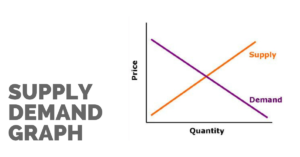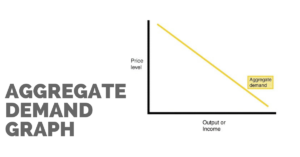In this article we are going to learn about – what is aggregate demand, what are its components, then we will see the standard formula used to calculate aggregate demand.
What is Aggregate Demand?
It is a term that is used in macroeconomics, which is used to measure the sum of all final goods and services that the consumers are willing to purchase in an economy during a certain period of time.
When you look at the term aggregate demand, there are two words in it ‘aggregate’ and ‘demand’. Aggregate means the sum total of different things, and demand simply means request or order.
In the academic setup, economics is divided into two parts macroeconomics and microeconomics. Under macroeconomics, we look at the large-scale factors of a nation’s economy such as – interest rates, GDP, national income, in other words, we look at the factors that affect a country’s economy as a whole. Under microeconomics, we look at the economic factors related to individuals like you and I or any individual product/commodity.
Now, aggregate demand clearly falls under macroeconomic context. But if we were to see demand in the microeconomics context, then we have to immediately think of the supply and demand graph. So it looks something like this.

On the y-axis, we have the price of a single commodity and on the x-axis, we have the output or the quantity sold of the same commodity. The demand slope tends to be a downward slope from left to right, and the interpretation is – as the price of a commodity increases demand is low. It’s natural if the price of a commodity is high why would you buy it, you could use that money to buy something else which can make you equally happy. Similarly, if the price is low, naturally the demand increases because people then think it’s an amazing deal, let’s go and buy it. So this is the demand graph in a microeconomics context.
Now when we move on to the macroeconomic context, the idea remains the same. It’s just that we are not talking about a single commodity, we are thinking about the economy as a whole, we are not talking about a market for any particular good or service. So keeping that in mind, on the y-axis we plot the price level. In other words, the general price level in the economy. On the x-axis, we plot the real GDP. What is real GDP? It is the actual production of total goods and services produced in the economy. We can also call it – the productivity of an economy, productivity means goods and services being produced.

And again we will see a downward sloping curve from left to right. This is called the aggregate demand. And the interpretation is – if the price level is high in the economy then the demand for the goods and services is low, likewise, people want more goods and services when prices fall. And this interpretation is true, if and only if all the other things that drive demand remains the same. And nothing changes.
What are the components of Aggregate Demand?
Well, it turns out that there are five components of aggregate demand. And surprisingly these are the same components that constitute GDP.
Let’s quickly understand each one of them.
- Consumer spending – in simple terms it is what you and I as individuals spend in return for our consumption. We can also say that it is the exchange of money for goods and services in an economy. We spend money to buy fuel, food, clothes, electronics, automobiles etc etc..
- Investment – when we say investment we refer to the investment made by companies, businesses for capital goods such as factories, equipment, buildings etc. The whole idea behind investment is that you purchase goods that you will not consume today but you will use it in the future to create wealth. Now if a company invest in a machinery, they are basically investing in future output that will generate money.
- Government spending – We saw what is consumer spending, therefore government spending is done by the government. Now the government spends on goods and services that are beneficial to the society. We can also call them public goods or public investment. These include – roads, Healthcare, education, welfare schemes, pension, military, police, public transportation etc. The money behind Govt spending comes from the taxes that the government collects from the citizens.
- Exports – They are demands for goods and services from other countries
- Imports – They are demands made by the domestic market which cannot be met by the domestic production. So to meet the demands of the domestic market countries import goods and services from other countries.
Calculating Aggregate Demand using formula
OK, so now we know the five components of aggregate demand? Looks like there is a standard mathematical formula that can be used to measure aggregate demand. And that formula is –
Aggregate Demand (AD) = Consumer Spending (C) + Investment (I) + Government Spending (G) + (Exports (X) -Imports (M)).
When you do [Exports (X) -Imports (M)] exports minus imports you get net exports.
This is also the mathematical formula for calculating the GDP.